Rustico Bay (Sept. 16)
 After Anne of Green Gables, PEI is all about beaches, scenery and lighthouses (at least 63). We decided to take the Central Coastal Drive through the beaches and dunes of PEI Island National Park. This is a very pretty drive, although you cannot really see the sea without stopping due to the trees and sand dunes.
After Anne of Green Gables, PEI is all about beaches, scenery and lighthouses (at least 63). We decided to take the Central Coastal Drive through the beaches and dunes of PEI Island National Park. This is a very pretty drive, although you cannot really see the sea without stopping due to the trees and sand dunes.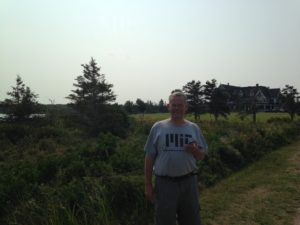

The sand here is brown (not red) and very very fine, like flour. We stopped at a couple of beaches to admire the view and the dunes.
Most of the lighthouses are red and white and are built on the lines of the one below. 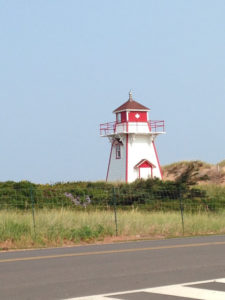 As well, miniature
As well, miniature
lighthouses are popular lawn ornaments. All of the lighthouses are now run automatically so the lighthouse keeper lifestyle is obsolete.
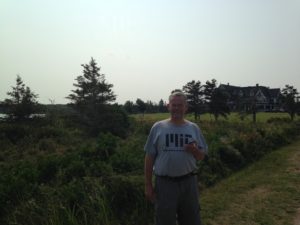 For lunch, we stopped at Dalvay by the Sea, a historic inn and ate on their glassed in balcony. Dalvay by the Sea was built by a Scottish American industrialist, Alexander MacDonald in 1896. The grounds and the part of the house that is open to folks using the restaurant are beautiful.
For lunch, we stopped at Dalvay by the Sea, a historic inn and ate on their glassed in balcony. Dalvay by the Sea was built by a Scottish American industrialist, Alexander MacDonald in 1896. The grounds and the part of the house that is open to folks using the restaurant are beautiful. 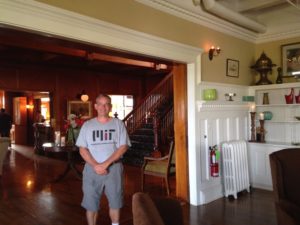 Our waitress, originally from Ontario, moved to PEI 9 years ago for a quieter lifestyle and more affordable housing and loves it.
Our waitress, originally from Ontario, moved to PEI 9 years ago for a quieter lifestyle and more affordable housing and loves it.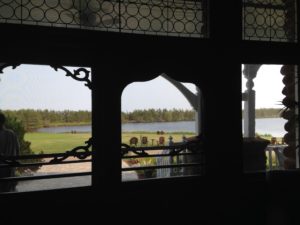
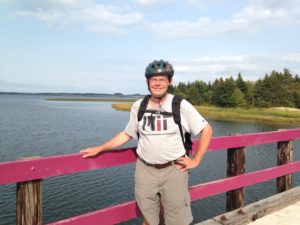
We then continued on to St. Peters Bay, where the bike trail runs right beside the bay for several kilometers between Morell and St. Peters. On the whole, the rail lines did not go too close to the coast due to the many inlets which would need to be bridged. However, this section has several very small bridges and is very scenic.
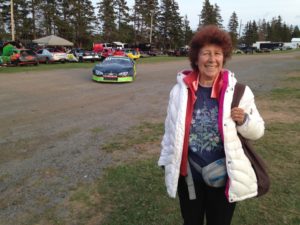 The campground closes for the season on Sept 17. We had booked until the last day, but the owner came around to tell us we could leave earlier if we wanted as stock car races originally scheduled for Sunday evening had been moved to Saturday due to the weather forecast. The speedway is separated from the campground by only by a row of trees that does not block the sound. The races are loud, and the owner wanted to give us the opportunity to leave before the noise started. Instead we decided to go to the races.
The campground closes for the season on Sept 17. We had booked until the last day, but the owner came around to tell us we could leave earlier if we wanted as stock car races originally scheduled for Sunday evening had been moved to Saturday due to the weather forecast. The speedway is separated from the campground by only by a row of trees that does not block the sound. The races are loud, and the owner wanted to give us the opportunity to leave before the noise started. Instead we decided to go to the races.
 Stock car races are loud – very loud. The cars do not have mufflers, and they might even have devices to increase the noise level. If we ever go again, I shall definitely wear earplugs. We noted that there were many families in the bleachers and usually the youngest children had earplugs or noise-cancelling headphones.
Stock car races are loud – very loud. The cars do not have mufflers, and they might even have devices to increase the noise level. If we ever go again, I shall definitely wear earplugs. We noted that there were many families in the bleachers and usually the youngest children had earplugs or noise-cancelling headphones.
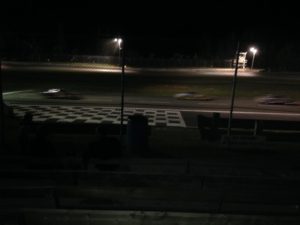 Stock car races are basicly roller derbies in cars. The cars go around a very short, very pitched oval from 10 to 50 times, 8 to 20 cars at a time on a two lane track. Needless to say, collisons and cars going off the track are frequent events. Pieces of fender and even bigger car chunks often go flying, and there is a 12 foot hgh fence between the track and the bleachers.
Stock car races are basicly roller derbies in cars. The cars go around a very short, very pitched oval from 10 to 50 times, 8 to 20 cars at a time on a two lane track. Needless to say, collisons and cars going off the track are frequent events. Pieces of fender and even bigger car chunks often go flying, and there is a 12 foot hgh fence between the track and the bleachers.
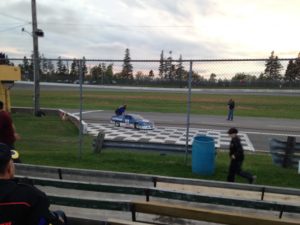 One event had minicars. We assumed that the drivers were kids, despite the relatively high speed of the race, until the very last race, when the category winners emerged from their cars. They were all normal sized men, and the grand winner have a grey beard and could not have been less than 50.
One event had minicars. We assumed that the drivers were kids, despite the relatively high speed of the race, until the very last race, when the category winners emerged from their cars. They were all normal sized men, and the grand winner have a grey beard and could not have been less than 50.
I have to say, watching the cars zip around the track and maneouver around one another to try to get the lead definitely had a fascination and we can see why people both race and watch the races. I am sure there is a fair amount of betting in the bleachers as well. One of the racers was camped beside us, and from him we learned that this is an expensive hobby, with low payback. Preparing a car to enter a race costs about $800, while the purse is in the $1000 range for a win. Nobody does stock car racing as their day job. However, I think it could appeal to someone who likes speed and also tinkering with auto mechanics and auto bodies. Most of the cars looked like they had taken a beating at some point.
With a Penn State game that evening, we decided to leave before the very last prizes were awarded. A long and satisfying day.
